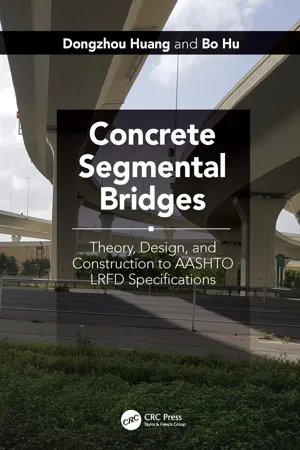
Concrete Segmental Bridges
Theory, Design, and Construction to AASHTO LRFD Specifications
- 982 pages
- English
- ePUB (mobile friendly)
- Available on iOS & Android
Concrete Segmental Bridges
Theory, Design, and Construction to AASHTO LRFD Specifications
About this book
Segmental concrete bridges have become one of the main options for major transportation projects world-wide. They offer expedited construction with minimal traffic disruption, lower life cycle costs, appealing aesthetics and adaptability to a curved roadway alignment. The literature is focused on construction, so this fills the need for a design-oriented book for less experienced bridge engineers and for senior university students.
It presents comprehensive theory, design and key construction methods, with a simple design example based on the AASHTO LRFD Design Specifications for each of the main bridge types. It outlines design techniques and relationships between analytical methods, specifications, theory, design, construction and practice. It combines mathematics and engineering mechanics with the authors' design and teaching experience.
Frequently asked questions
- Essential is ideal for learners and professionals who enjoy exploring a wide range of subjects. Access the Essential Library with 800,000+ trusted titles and best-sellers across business, personal growth, and the humanities. Includes unlimited reading time and Standard Read Aloud voice.
- Complete: Perfect for advanced learners and researchers needing full, unrestricted access. Unlock 1.4M+ books across hundreds of subjects, including academic and specialized titles. The Complete Plan also includes advanced features like Premium Read Aloud and Research Assistant.
Please note we cannot support devices running on iOS 13 and Android 7 or earlier. Learn more about using the app.
Information
1Introduction to Concrete Segmental Bridges
- Development of concrete segmental bridges
- Construction materials and their properties
- Types of concrete segmental bridges and typical construction procedures
- AASHTO stress limits
- Post-tensioning systems
- General design procedures
- Aesthetics
1.1BRIEF HISTORY AND DEVELOPMENT OF CONCRETE SEGMENTAL BRIDGES


Table of contents
- Cover
- Half Title
- Title Page
- Copyright Page
- Dedication
- Contents
- Preface
- Acknowledgments
- Authors
- Unit Conversion Factors
- Principal Notations
- Chapter 1 Introduction to Concrete Segmental Bridges
- Chapter 2 Loads on Bridges and General Design Methods
- Chapter 3 Fundamentals of Segmental Bridge Analysis and Design
- Chapter 4 General Analytical Theory of Super-Structures
- Chapter 5 Design of Span-by-Span Construction and Common Details of Concrete Segmental Bridges
- Chapter 6 Design of Cantilever Segmental Bridges
- Chapter 7 Design of Incrementally Launched Segmental Bridges
- Chapter 8 Design of Post-Tensioned Spliced Girder Bridges
- Chapter 9 Design of Concrete Segmental Arch Bridges
- Chapter 10 Design of Concrete Segmental Cable-Stayed Bridges
- Chapter 11 Design of Substructure
- Chapter 12 Segmental Bridge Construction
- Appendix A: AASHTO-PCI-ASBI Segmental Box Girder Standards for Span-by-Span and Balanced Cantilever Construction
- Appendix B: Typical Prestressing and Stay Cable Systems Provided by Freyssinet and TENSA
- Index